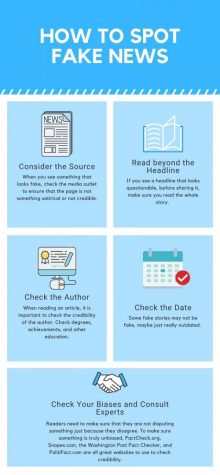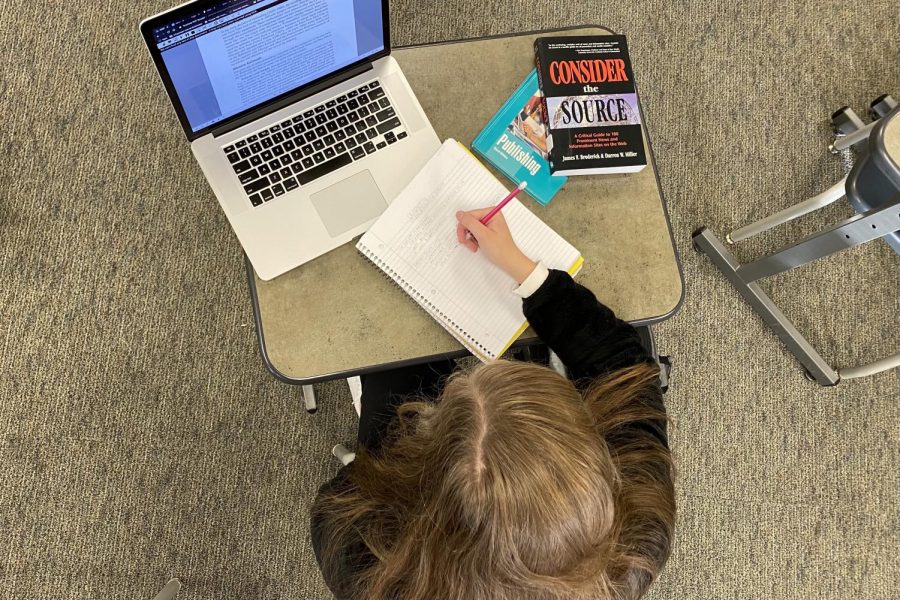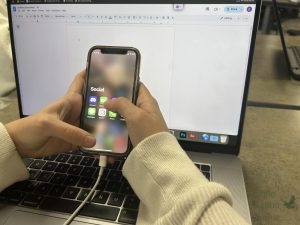Editorial: Journalism or fake news – find the facts
Writing her “Writer of the Year” entry for the NSPA contest, rising senior Gabriella Winans sits at her desk. This will be Winans third year writing for the newspaper. “I’ve talked to people states away, and it’s allowed me to grow in ways I never expected,” Winans said. “I believe that just listening to people share their stories can allow you a glimpse into their lives, a walk in their shoes — even if it’s a short one.”
November 13, 2020
Fake news. Defund the media. Sloppy journalism — these are the terms that are flying around in today’s hostile political news environment. The line is unclear between actual fake news and just something that someone disagrees with. When it comes to publishing news, journalists receive hate — even if they are just reporting the facts.
Journalists are not completely at fault for the spread of fake news, and just because someone disagrees with a fact does not mean that it is fake news.
Media outlets that spread untruthful news harm ethical journalists. According to Time Magazine, the public takes journalistic objectivity the wrong way. Journalistic objectivity requires journalists to present facts, and it is up to the audience to interpret the information. Time explains that since the 1960s, the true meaning of journalistic objectivity has changed, but it is still happening today. But, because of the more than ever heavily opinionated public, the information coming from the news outlets that are still practicing true objectivity is seen as an attack.

When something is coming from a credible and unbiased source, people need to understand that coverage is needed, even if they do not agree with the content. It is a journalist’s job to bring attention to issues within the world. If anything, media outlets have biases, and it is up to the journalist on how they cover the topic. It is up to the reader to figure out these underlying biases and to use steps to identify the credibility of a source. Plenty of “fake news” is fake, but audiences should be aware of the source and bias occurring throughout the industry. In today’s world spotting fake news is an essential skill adults and teenagers should use more than ever. True journalists cannot do anything but report the news factually to combat the ulterior-motivated journalists who spread false information. According to FactCheck.org, some simple ways to check the credibility of an article include reading beyond the headline, checking the author, checking dates, checking for satire, checking biases and supporting evidence for the claims.
People are also switching to other social media platforms because they feel like Facebook and Instagram are favoring one party versus the other, which is simply not true. With the election tensions still occurring, claims of voter fraud have circulated. Even though these claims are not proven and have very little evidence by election officials, many people are still upset. As a result, many Facebook users have said they feel like they are being “de-platformed” because of Facebook censorship that flags claims as false, including topics of COVID-19, election fraud and hate groups. To escape the censorship, they are switching to a different app called Parler. In this article, Parler’s creator inferred that he is a part of the far-right groups that spread this fake news because he spends his time “banning trolls” from the app. The trolls he is referring to are “left-leaning teenagers” who use facts from news sources to debunk their claims. If the informational claims made by the new Parler users were truthful, Facebook, Twitter and Instagram would not have flagged these posts in the first place. People switching to these platforms show that journalists can not be the only ones at fault for spreading fake news. People cannot complain about something being fake, then spread more of it. Users should take steps to check if something is true before automatically resharing it because they agree with what they see. Journalists want to do their best to be trusted and helpfully serve their audience.
Although some journalists are at fault for creating false news, most fake news actually comes from fake news generators, where it is easy to create real looking headlines and stories. BBC News says that there are five types of people who start the spread of fake news. Individual journalists are not usually the ones to blame for creating fake news when there are many more false stories spread by generators. Social media is also often used as a source of information but is not always reliable.
To alleviate the amount of false news, people need to fact check the sources of things they see online, and to accept that not everything they disagree with is fake news. Not all journalists are responsible for the spread of fake news, and often generators or biased media outlets are the cause of misinformation. In today’s heavily political news domain, it is vital for news followers to check their sources.
Editor’s note: Neena Sidhu penned this editorial on behalf of the staff of Eagle Nation Online.

























